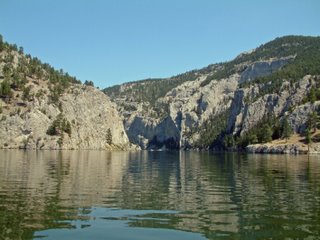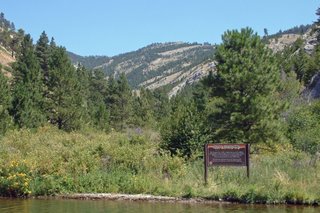 Twenty miles North of Helena along the interstate is an interesting geological formation known as the "Gates of the Mountains". In July 1807, as the Lewis and Clark expedition was working its way up the Missouri River along the rolling plains, they came to the place where the Rocky Mountains abruptly begin. From a distance, the river seems to disappear into the rock; only when you approach can you see where the river enters the tall cliffs, hence the description by Meriwether Lewis that this place was the "Gates of the Rocky Mountains". Today a downriver dam has created a lake and deep channel through the area and Brenda and I, along with our fellow fulltimer friends Dennis and Ann, boarded a tour boat for a two-hour tour (where have I heard that before?). With an entertaining tour guide/captain, blue skies, and calm water, we entered the "gates" and began our tour. The sheer canyon walls rise as much as 1200' on either side of river and in many areas were heavily forested. We saw eagles and an unusual cliffside osprey nest with fledglings, who watched us as we motored by.
Twenty miles North of Helena along the interstate is an interesting geological formation known as the "Gates of the Mountains". In July 1807, as the Lewis and Clark expedition was working its way up the Missouri River along the rolling plains, they came to the place where the Rocky Mountains abruptly begin. From a distance, the river seems to disappear into the rock; only when you approach can you see where the river enters the tall cliffs, hence the description by Meriwether Lewis that this place was the "Gates of the Rocky Mountains". Today a downriver dam has created a lake and deep channel through the area and Brenda and I, along with our fellow fulltimer friends Dennis and Ann, boarded a tour boat for a two-hour tour (where have I heard that before?). With an entertaining tour guide/captain, blue skies, and calm water, we entered the "gates" and began our tour. The sheer canyon walls rise as much as 1200' on either side of river and in many areas were heavily forested. We saw eagles and an unusual cliffside osprey nest with fledglings, who watched us as we motored by.  A real treat was seeing a
A real treat was seeing a river otter family with two pups; they seemed curious and entertained us with their play until the parents decided it was time to move on. We continued down the river to Mann Gulch, the site of a tragic wildfire in 1949 where 13 firefighters, the majority "smoke jumpers" were killed.
river otter family with two pups; they seemed curious and entertained us with their play until the parents decided it was time to move on. We continued down the river to Mann Gulch, the site of a tragic wildfire in 1949 where 13 firefighters, the majority "smoke jumpers" were killed.
 It's a fascinating story of one of the first recorded "blowups", a phenomenon that creates a tornado-like fire which is estimated at Mann Gulch fire to have burned over 2000 acres in less than two minutes. Only three smoke jumpers survived; two young men who managed to outrun the fire and the foreman who amazingly made the decision to build an escape fire once he realized he could not outrun the flames. He set an area of brush on fire, laid down with a wet cloth over his face, and let the fire race over him. He later said that the fire picked him up and threw him down three times, yet he survived without injury. The event is described in a riveting book, "Young Men and Fire" written by Norman Maclean, who also wrote "A River Runs Through It". Near the gulch and accessible only by boat is a beautiful memorial and picnic area. The tour guide did a great job of describing the sequence of events and made it easy to visualize how the fire developed. A good synopsis of the fire is on a US Forest Service web site at www.fs.fed.us/rm/pubs/int_gtr299/.
It's a fascinating story of one of the first recorded "blowups", a phenomenon that creates a tornado-like fire which is estimated at Mann Gulch fire to have burned over 2000 acres in less than two minutes. Only three smoke jumpers survived; two young men who managed to outrun the fire and the foreman who amazingly made the decision to build an escape fire once he realized he could not outrun the flames. He set an area of brush on fire, laid down with a wet cloth over his face, and let the fire race over him. He later said that the fire picked him up and threw him down three times, yet he survived without injury. The event is described in a riveting book, "Young Men and Fire" written by Norman Maclean, who also wrote "A River Runs Through It". Near the gulch and accessible only by boat is a beautiful memorial and picnic area. The tour guide did a great job of describing the sequence of events and made it easy to visualize how the fire developed. A good synopsis of the fire is on a US Forest Service web site at www.fs.fed.us/rm/pubs/int_gtr299/.Turning back downriver, our guide pointed out an arch located high on the mountainside, and later an interesting formation called "rhino rock" for obvious reasons.


Finally, as we neared the dock we saw probably the most unusual sight of the day.......check out the boat with the hound hood ornament. He was having a ball; ears flapping and baying - we all enjoyed the show!
